Photo by Greg Aiello
“I have an unfair advantage,” says Charlie Hunter. “I was exposed to all of that blues stuff at a very early age. That was just the music that was on in my house all the time because of my mom.” Thanks to mama Hunter, that music has inspired and influenced one of the most progressive and unique guitarists to come out of the free-flowing Bay Area jazz scene of the early ’90s. And even though Hunter didn’t follow the musical path of the rural blues artists he was listening to, you can hear where his deep sense of rhythm came from.
That rhythm is what sets Hunter apart from every other 7-stringer around. His contrapuntal style has baffled guitarists (and bassists) for nearly two decades. Building on the vernacular of jazz guitarists Lenny Breau, Bucky Pizzarelli, and George Van Eps, Hunter has expanded the instrument by combining the lower three strings from a bass guitar with the middle four of a standard guitar to create something entirely new. “A guitar player could get on my instrument and get around on it after a couple of hours and figure out a few things,” says Hunter. “But if you are doing it ‘right,’ you aren’t really doing it like a bass or a guitar.”
Creating a singular bi-polar sound from one instrument is the centerpiece of Hunter’s latest album, Not Getting Behind is the New Getting Ahead. Along with longtime collaborator, drummer Scott Amendola, Hunter gets to the essence of his sound by stripping away extraneous elements. We spoke to Hunter just days before heading out on a lengthy fall tour to discuss touring in tough economic times, finding a drummer with a death-ray pocket, and why he loves to record in “mostly mono.”
You have played in several
different configurations.
What prompted you to
record a duo album?
I have been touring duo for
quite some time. I have done a
lot with Derrek Phillips, with
Eric Kalb, with Bobby Previte.
I’ve done duos with drummers
for years. Scott [Amendola] and
I have been playing together for
like 20 years.
Does that go back to before
the T.J. Kirk days?
Yeah, and a bunch of those Blue
Note records as well. We just
have a great rapport. I had been
working on music for a while
and we had played a lot of gigs
together and also it was obviously
a recessionary thing.
Was that because of the
expense of taking a band
on the road?
It got to the point where I
couldn’t go out with a trio.
It wasn’t the guys’ salaries so
much, although that was a big
part, it had to do with the travel
and hotels. At the end of the
year it was time to pay the bills
and I didn’t have any money.
Also, it created a situation where
I was like, “Wait a minute, I
really like playing in this format
for more reasons than just the
economic ones.” There’s a certain,
more intimate kind of vibe
when you’re playing this thing.
It brings the audience in. And
also, when you don’t have the
horn element in it, you don’t
have the overt jazz element in it.
That feeling must be really
liberating.
The sky’s the limit conceptually
because you can do treatments
of music you really can’t do with
the horn—for better or for worse.
The horn is the jazz instrument
and when you play drums or guitar
or even something crazy like
my instrument, you really have to
defer a lot to the horn player sonically.
It’s real easy to wipe them
out and generally that means
having to play to their strengths,
and not always your strengths.
Your palette widens in terms of
the stuff you can get to, so what
you lose with that third voice you
make up for in an ability to really
pick from so many vernaculars.
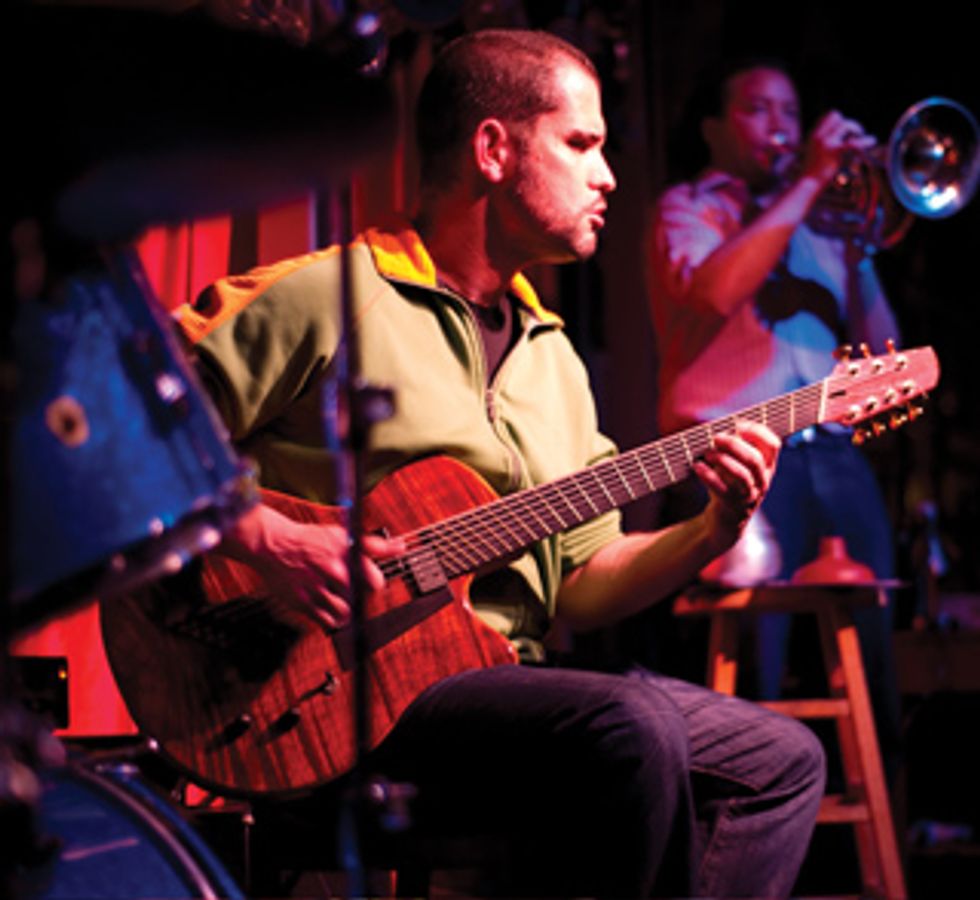
Charlie Hunter digs into his custom Jeff Traugott 7-string, which features a Bartolini bass pickup and a Lollar 4-pole guitar pickup. Photo courtesy of JP Cutler Media
When you compose, do you
have the group format in mind?
I wrote everything on this
album specifically for this format.
Of course there is some
jazz stuff through it in terms
of the improvisation and some
of the structures, but I wrote it
really with my instrument’s vernacular
in mind. I was thinking
a lot about players who are
the quintessential guitarists I
really admire, like Blind Blake,
Joseph Spence, and John Lee
Hooker—more open, rhythmic
kind of playing. I merged that
with whatever you want to
call that improvising sensibility.
With most of the guys I
play with I don’t even do a
rehearsal. Maybe, just maybe,
I will let them listen to the
record. But sometimes I don’t
want them to.
Were the arrangements done
in the studio?
We had played these tunes
for a while on the road. The
arrangements, you know, I hate
to say it, but we will change
the arrangement from night to
night just on the fly. Because
that is what you can do with
a duo. Mostly, I just explained
to Scott what the mood of the
tune was and we would take it
from there. The most important
aspect of this way of playing is
to really deal with space. And I
don’t mean dealing with space
in an abstract way, but really
using the rests between whatever
musical gestures you are making—
really feel those rests and
use them as a kind of gesture by
and of themselves. When you
are dealing with less sound, the
space becomes more dramatic.
Is there a way you can
practice that?
I have always been practicing
that and what that comes down
to is really being rhythmically
astute. I practice a lot of drums
and I don’t practice drums to
be like, “Oh man, check out
that guy. He has chops.” I get
on the drum set and I try to
get a half hour or hour in with
a metronome. Just really dealing
with a very simple beat, the
subdivisions, and the rests. I
really want to make that pocket
thing as deep as possible. When
you do that, it’s a great tool for
expression because if you are a
guy like me and your instrument
is kind of complex rhythmically
with the counterpoint,
your gestures become a lot
more powerful than if you are
just noodling all over the place
as much as you can.
Some music educators claim
that using a metronome can
make your time feel stale
and stiff. Are you adamant
about using a metronome
when you practice or do you
sometimes work on time
away from the click?
I do both. You should be able
to do both. I think everyone has
some kind of natural sense of
beat. A lot of the New Orleans
people I play with have a slightly
“behind” kind of thing. Where
I come from in the Bay Area,
every 16th-note is accounted
for and ahead of the beat, pushing
it. Some people, they really
spend a lot of time trying to get
on the beat—even guys around
today like Matt Chamberlain,
Shawn Pelton, or Steve Jordan,
guys who play more pop gigs.
Those guys are complete and
total masters of that.
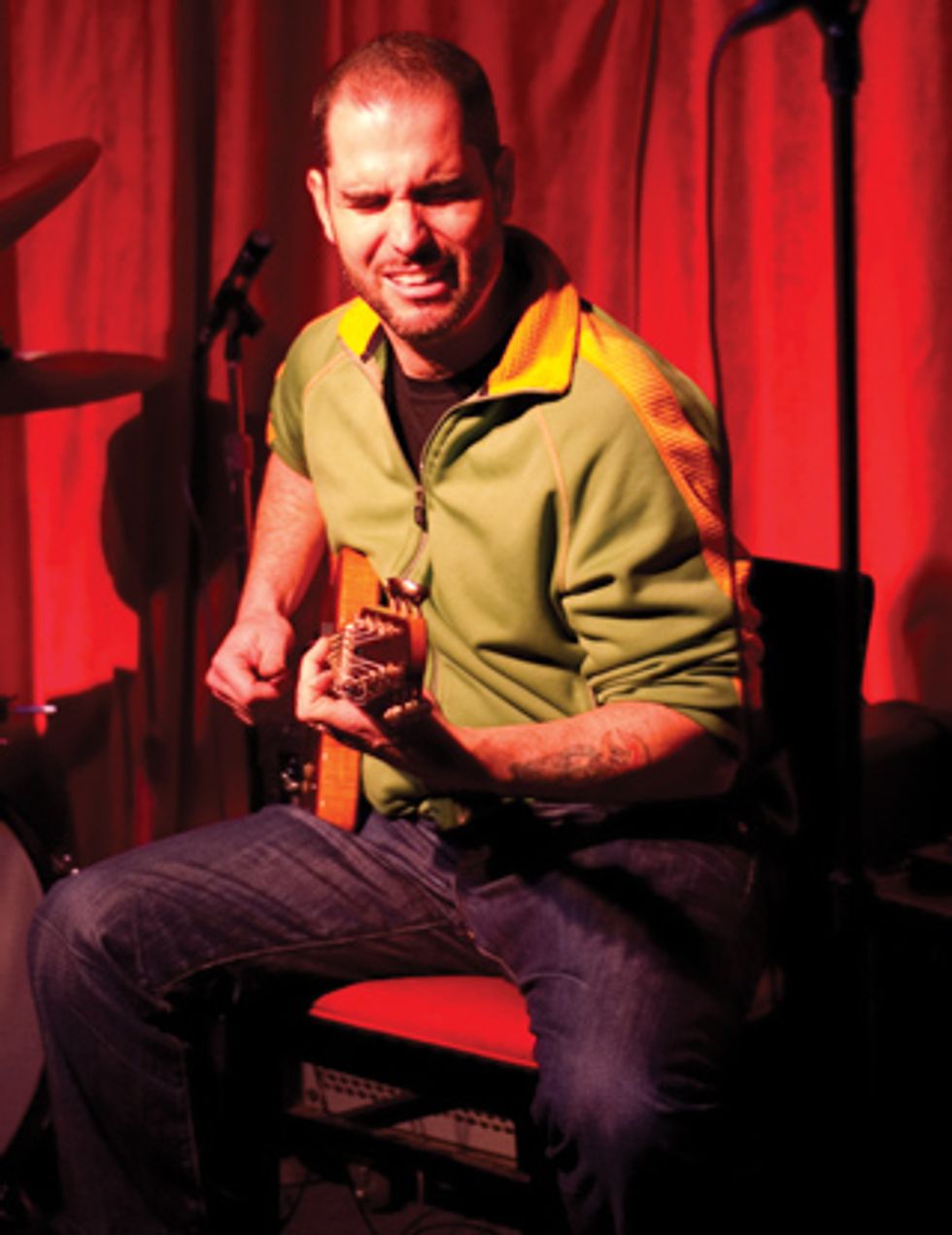
“The most important aspect of this way of playing,” says Hunter, “is to really deal with space.” Photo courtesy of JP Cutler Media
That’s the kind of thing you always think of when you are playing with the metronome. You are trying to feel how big that beat is and explore as far back as you can go, as far forward as you can go, and then playing right on it. It also becomes a thing where you are playing with it. It’s your friend. That thing is your buddy and you are playing with it, and then you start to really feel and appreciate counterpoint and where the beats are actually supposed to feel interdependent. I don’t feel stale ever. It always feels good to me.
What do you look for in
a drummer?
Generally, there are a couple
of things. It’s great to have a
fantastic death-ray pocket. But
then again, everyone has their
own. For instance, if you listen
to someone like Tony Mason,
who is a guy I play with a lot
in New York, he has one of the
deepest, straight-groove pockets
I have ever played with. It’s
very obvious when you hear
him play. He gets very creative
with it. Then you can hear a
guy like Paul Motian and you
think, “It’s all over the place,
this is crazy. I don’t get it.” But
when you really listen, you
realize that although he may be
playing in an abstract fashion,
what you are hearing is an
incredible pocket.
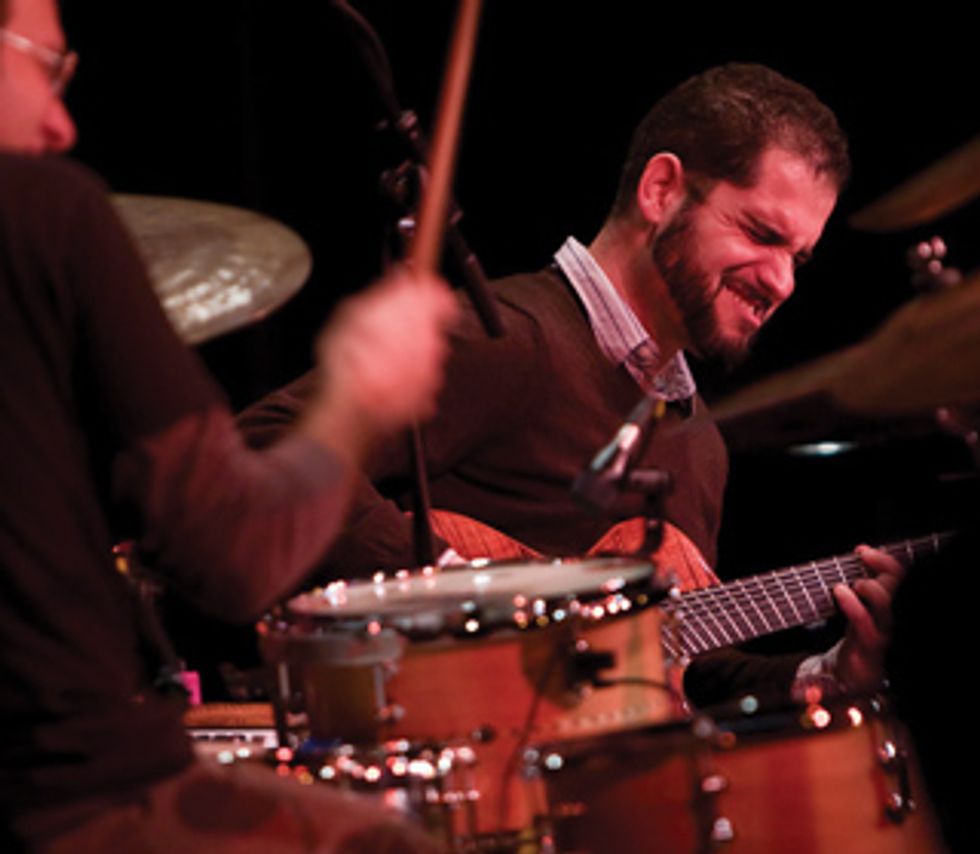
“You want to have a drummer—at least I do—who understands narrative,” says Hunter, shown here with Scott Amendola. Photo courtesy of JP Cutler Media
Pocket is a big thing and it’s a wide-ranging thing, but it’s not just about pocket. You want to have a drummer—at least I do—who understands narrative. And it might be something as dense as Elvin Jones or as sparse as how Jim Keltner would play through a pop song. To me, the great ones always have that narrative going. Even if as a listener you have to tune in to hear it. The most powerful ones will be the narratives that are most honest to who they are and what their experience is.
What was your most recent
musical breakthrough?
I have been messing around
with a tuning. I’ve never really
messed around with alternate
tunings since I was a kid, but
I have been detuning my low
G-string to F and my high
B-string to C, so it gives this
weird way to get to some different
fingerings and stuff. Also,
just trying to deal with a lot
of right-hand fingering stuff.
Open it up a little more.
How did you first learn about
Jeff Traugott’s instruments?
Ralph Novak had made my
instruments for many years and
I met Jeff because he offered to
make me an acoustic. Then we
got to talking and he just did
some really cool stuff. I’ve had
this same guitar for going on six
or seven years at this point.
Traugott is more known for
his flattop guitars.
Yeah, he is. I am hoping to get
one someday. This guitar is really
simple. Just a solidbody with
a bolt-on neck, a bass pickup,
and a guitar pickup. Jeff is
making me another solidbody
instrument with a shape similar
to his Model R, but with a cutaway.
After that, I will probably
call it a day.
What pickups are you using?
The bass pickups are Bartolini
pickups and Jason Lollar specially
made the guitar pickups for
me. They only have four pole
pieces. I really like the way they
sound and because they only
have four pole pieces, it’s a really
different sound. Technically,
it’s a humbucking pickup, but
since it has the smaller diameter
it sounds and feels more like a
single-coil pickup.
Since moving from 8-string to
7-string it seems like you have
finally settled on a tuning that
works for you.
Yeah, it has gone through some
iterations over the years. Back
in the day, when I was playing
8-string on all those Blue Note
records, I was really trying to be
a bass and a guitar and cover all
that ground, but there are some
inherent issues with that. One
is that even at a low-string scale
length of 29" and a 25.5" scale
on the high side, the bottom
E is super floppy, you know?
There was a time when I tuned
it up to F and the whole thing
went up a half-step. I dumped
the 8-string eight or nine years
ago, and I have been using a
tuning that really works for this
scale length, which is G–C–F–
C–F–B%–D, from low to high.
So, basically, it sounds really weird, but it’s not. It’s just the lower three strings on a bass and the middle four of a guitar with a capo at the third fret. And it works really well for the bass because you get that pumpy tightness that the drummers can really feel.
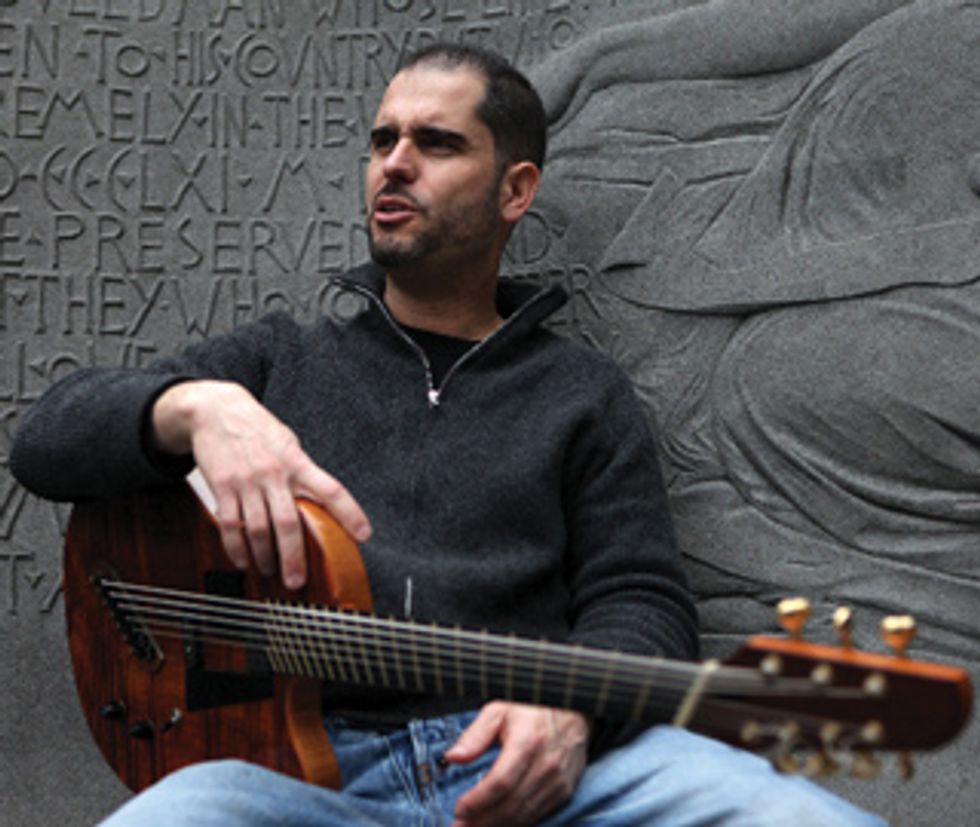
Photo by Greg Aiello
It seems like the intervals
between the strings aren’t that
different from a typical 6-string.
Its funny you should say
that, because whenever I play
6-string guitar, I’m like, “What
is this?” My instrument’s thing
is to think vertically and how
the beats line up and the interdependence.
That’s how this
thing shines.
Your tone on the last few
albums is clear and pure. It
sounds like you used very
little effects or processing.
Yeah, I think it’s just a culmination
of where I have been at
for the last two or three years.
About four or five years ago I
really stopped wanting to be a
bass player and a guitar player
together, and finally fully committed
to what this instrument
is. When I changed the tuning
on it I realized all of these
things are really ultimately
detracting from what I want to
achieve with the instrument.
Like the volume pedal, I got
rid of that quickly, and the
Leslie speaker thing, I got rid
of that. I got rid of all those
things because I felt like they
weren’t helping me in terms of
being more expressive. They
were taking away from the
rhythmic integrity of what the
instrument had to offer because
I was constantly thinking, “I
am going to do something
with my feet now.” I also felt I
could just get so many different
sounds without effects.
Another part of it, my friend Jim Campilongo has this thing going with his Tele and a Princeton. He gets like 20 distinctly different sounds from that setup. Who knows what will happen in time, I may go back to using more effects. I just like that sound and I feel like I can get to a lot of different sounds because I am playing with my fingers. Right off the bat that gets you further sonically than playing with a pick.
Since switching to your current
instrument, tuning, and
setup, how has your vocabulary
changed?
I am a much better editor
now. I think I have the same
vocabulary but I found the stuff
that is more honest in terms of
how I am speaking through the
instrument, if you want to use
the vocabulary thing. I am just
trying to condense it down to a
more Ernest Hemingway-style
of declarative sentences with as
much meaning as I can muster.
So, in that way, yeah, there is
less of it and hopefully it’s more
meaningful. But the audience
has to make that decision.
If someone unfamiliar with
your music wanted to check
out what you do, would you
recommend starting with
this album?
Yeah, I think I would say this
one, not because it is the latest
one, but just because you feel
like with this kind of thing, you
are always working and refining
what you are doing. On this
album there is less extraneous
bullshit or psychological issues
I’m working out within the
music. It’s just designed to liberate
the audience from the tyranny
of conscious thought. With
my older stuff, there’s a record
called Ready, Set, Shango that
people like. It just had a vibe
that you could only get with a
band that is playing together all
the time. But there is too much
guitar noodling on it for me.
In addition to your Traugott
7-string, what was your amp
setup for this album?
I didn’t use any effects. I had
this Carr Rambler for the guitar
side, and I plugged directly into
it. The studio had an Ampeg
V4B and I used it for the bass.
We also used one of those old
Fender amps [Pro Reverb] with
a 15" speaker. We turned the
bass all the way up and the
treble all the way down, and it
wasn’t on very loud.
The only thing we were using
it for was to get a little extra
thunk out of the guitar side of
the instrument, since we set
up right next to each other in
the room without headphones
and just played.
As a listener, it really sounds
like I’m sitting right between
you two.
Yeah. Since that’s what we do
most of the year, maybe when
we make a record it should be
that. We did use a little studio
trickery. We recorded live to
1/2" tape and it was mixed while
we were recording it. I usually
like to record in mono, but this
album isn’t exactly in mono.
It’s this thing we call “mostly
mono,” which means if you put
it up on a scope, it would appear
90-percent mono. Basically all
of the instrument information is
mono, but the entire ambience
is stereo. There are a couple of
room mics up, and that’s the
ambient stuff. It’s not even a very
wide stereo, but it gives you the
best of both worlds.
You hear everything as one
gigantic instrument, but it’s
not all blocky and in your
face because it has that stereo
ambience to it.
Did I hear some tremolo on
“Assessing the Assessors”?
Yeah, and that was just the
tremolo on the Carr. That
Fender was on so low, it was
almost imperceptible. Because
of the way we were recording
it, the drums were eating up
the Carr’s thunk, so we just felt
like we needed something extra.
Charlie Hunter's Gear
Guitars
Custom Jeff Traugott solidbody with Bartolini bass
pickup and Jason Lollar guitar pickup
Amps
Carr Rambler, vintage Fender Pro Reverb
Effects
Strymon Lex Rotary, Strymon Flint
Tremolo and Reverb
Strings
D’Addario strings
(.100, .080, .065, .038, .028, .017, .013)
Are you thinking of taking
any effects at all on the road?
I had this tour in Europe
with Kurt Elling, and it was
just him, Derrek Phillips, and
myself. He wanted to have
a little more sonic stuff and I
think they wanted me to try out
the Leslie sound again, which I
personally just can’t stand. It’s
like when you’ve worked in a
pizza parlor for too long, you
never want to eat pizza again. I
know it’s a brilliant, wonderful
sound, but I just had too much
of it. I overused it. I called up
Strymon and got their Leslie
thing [Lex Rotary], and I can’t
believe how good it is. It blew
me away. It beats the living shit
out of any other Leslie device I
have tried, other than the actual
cabinet. When I am doing
tours where I have to backline
stuff, the amps are always awful.
Often times, the reverb doesn’t
work, so I was thinking of the
[Strymon] Flint as an insurance
policy. At least I know that I will
have this sound regardless of
how bad the gig gear is.
YouTube It
Opening with an introspective, harmonic-laden
intro before launching into a serious groove,
Charlie Hunter was in fine form at the Portland
Jazz Festival earlier this year.
While on tour, Charlie stopped into Premier
Guitar headquarters to talk about the blues
and play some tunes.
While on tour in Europe this year, Hunter
teamed up with Kurt Elling to deliver the tender
ballad “Save Your Love for Me.”



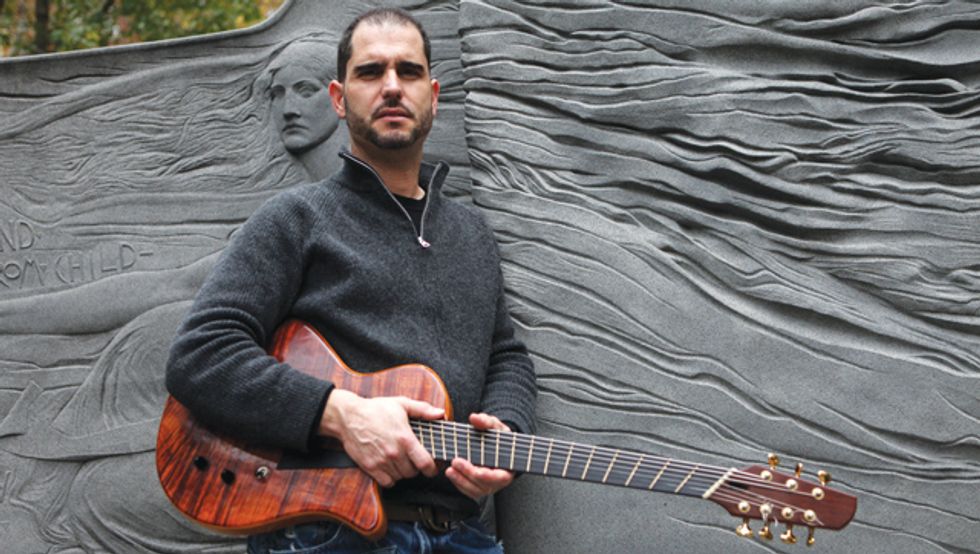







![Rig Rundown: Russian Circles’ Mike Sullivan [2025]](https://www.premierguitar.com/media-library/youtube.jpg?id=62303631&width=1245&height=700&quality=70&coordinates=0%2C0%2C0%2C0)













![Rig Rundown: AFI [2025]](https://www.premierguitar.com/media-library/youtube.jpg?id=62064741&width=1245&height=700&quality=70&coordinates=0%2C0%2C0%2C0)




















 Zach loves his Sovtek Mig 60 head, which he plays through a cab he built himself at a pipe-organ shop in Denver. Every glue joint is lined with thin leather for maximum air tightness, and it’s stocked with Celestion G12M Greenback speakers.
Zach loves his Sovtek Mig 60 head, which he plays through a cab he built himself at a pipe-organ shop in Denver. Every glue joint is lined with thin leather for maximum air tightness, and it’s stocked with Celestion G12M Greenback speakers.











